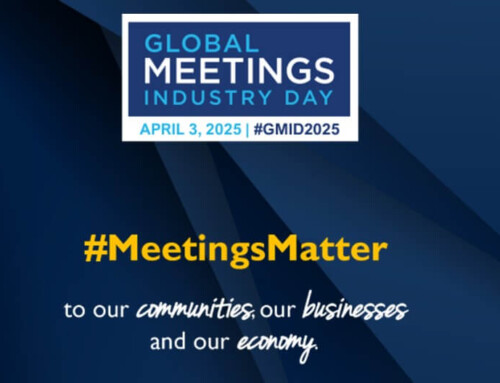This article includes historical information for context. While the core content remains valuable, some details reflect past events and may not be up to date. We regularly update our blog to keep you informed of current insights.
While hybrid events have become more familiar concepts to people over the past year, there is still a level of discomfort. Why is it critical for attendees to feel at ease with these meetings, especially the in-person component of hybrid events?
As the number of people receiving COVID-19 vaccinations increases, masks and social distancing will become less common at the venues. It is imperative for in-person attendees to feel safe and to receive the elevated experiences they encountered before the pandemic. Meeting planners have tried to fill the void of experiences with virtual events. However, nothing will quite live up to those had in-person.
As projections expect a return to more live events mid-2021, companies can build attendees’ confidence in the hybrid and in-person events they host.
Let Attendees Know Exactly What to Expect
A lack of confidence often accompanies a lack of information. Hybrid events and in-person events were scarce in 2020, while virtual meetings skyrocketed. Attendees need more information about the meetings taking place in the post-pandemic era.
Attendees need to be clear about the difference between a hybrid event vs. a virtual event. Unfortunately, many attendees mistake virtual events as merely live streaming, pre-recorded, or something like Microsoft Teams or Zoom.
Companies should fill potential and registered attendees in on all the compelling details, including the exciting breakout sessions and networking opportunities planned for them. Agendas should be thoughtfully outlined, speaker bios should be fleshed-out, and big announcements should be tantalizingly teased.
Some people may still be leery about attending an in-person meeting after months spent quarantining from a psychological standpoint. For this reason, the hosting business must assure in-person attendees that the venue is a safe space for them.
Time will tell what safety protocols are in cleaning protocols, air circulation, mask-wearing, social distancing, etc. It does mean that attendees need to be assured that the company (and all vendors) are following all safety measures involved in hosting a meeting.
Make Technology Easy
It is typical for people to feel intimidated by the idea of using new technology. The software platform used for the virtual piece of hybrid meetings is no exception. Attendees may assume the program will be too challenging for them to use and may even pass on the event altogether for this reason.
This issue can be remedied by providing virtual attendees with clear, detailed directions on using the software. They should include both written instructions and screenshots, cover people who learn through reading and those who are visual learners.
Attendees must be provided access to contact details for information technology (IT) specialists to help them. The knowledge they are not in it alone is comforting and helps virtual attendees feel like they will not miss anything important due to technical glitches.
Increase the Marketing Budget
The level of transparency addressed in this article requires communication to reach attendees. This is one reason why allocating a robust marketing budget for the event is crucial. Even the most fantastic hybrid or in-person event is likely to fail if target audiences are unaware of its best points.
As stated previously, knowledge builds confidence. Event planners recognize this fact, with 52 percent predicting spending more on meetings in 2021 than they did before the pandemic. (1)
Right now, the goal of marketing is two-fold: sharing information about the highlights of the meeting and reassuring attendees that their safety is paramount to event organizers. Safety includes in-person audiences (some attendees may still have COVID-19 concerns despite the vaccine, but another consideration is crisis planning and assuring attendees that safety and security protocols are observed for a variety of situations and scenarios) and the virtual end (attendees want to know the connection to the event is secure enough to protect their data).
The following tactics are effective strategies for marketing a hybrid or in-person event:
- Leverage social media to convey the value the meeting offers attendees; social media post ideas include sharing “best of” elements from previous events to demonstrate the level of quality.
- Send email campaigns to attendees of previous events, people who have donated to or sponsored past meetings and mailing list subscribers; incorporate personalization and make subject lines engaging by avoiding the standard “Registration opens on…” copy.
- Ask speakers and, if applicable, exhibitors to promote the event to their networks; this endeavor is mutually beneficial. These stakeholders have their interest in the outcome of the meeting.
- Expand the potential audience for the event and bolster credibility by partnering with another organization to co-brand it; it is critical to choose a partner that has a similar audience.
- Go the extra mile with a branded website dedicated to the meeting (or, if budget constraints prohibit building an entire website, a webpage) and blog and video content that centers around the event.
Planning and executing is only half of the equation when it comes to the formula for a successful event. Gaining the confidence of potential and registered attendees in the value and safety the meeting offers is the other half. Implementing the strategies provided in this article will generate the desired results.
Uncertain times call for creative thinking. Contact Gavel International to be inspired by solutions that connect and engage your people.
____________________________
SOURCES:
1 https://www.cit-world.com/interviews/event-spend-will-be-higher-in-2021-than-it-was-pre-covid
This article was last updated on May 9, 2025
- Why Hustle Culture Can Harm Sales Success – and How to Repair the Damage - June 30, 2025
- Enhance Sales Through Team-Friendly Storytelling - May 5, 2025
- Unlocking Excellence: The 7 Traits of Top Performers and Their Impact - April 14, 2025






